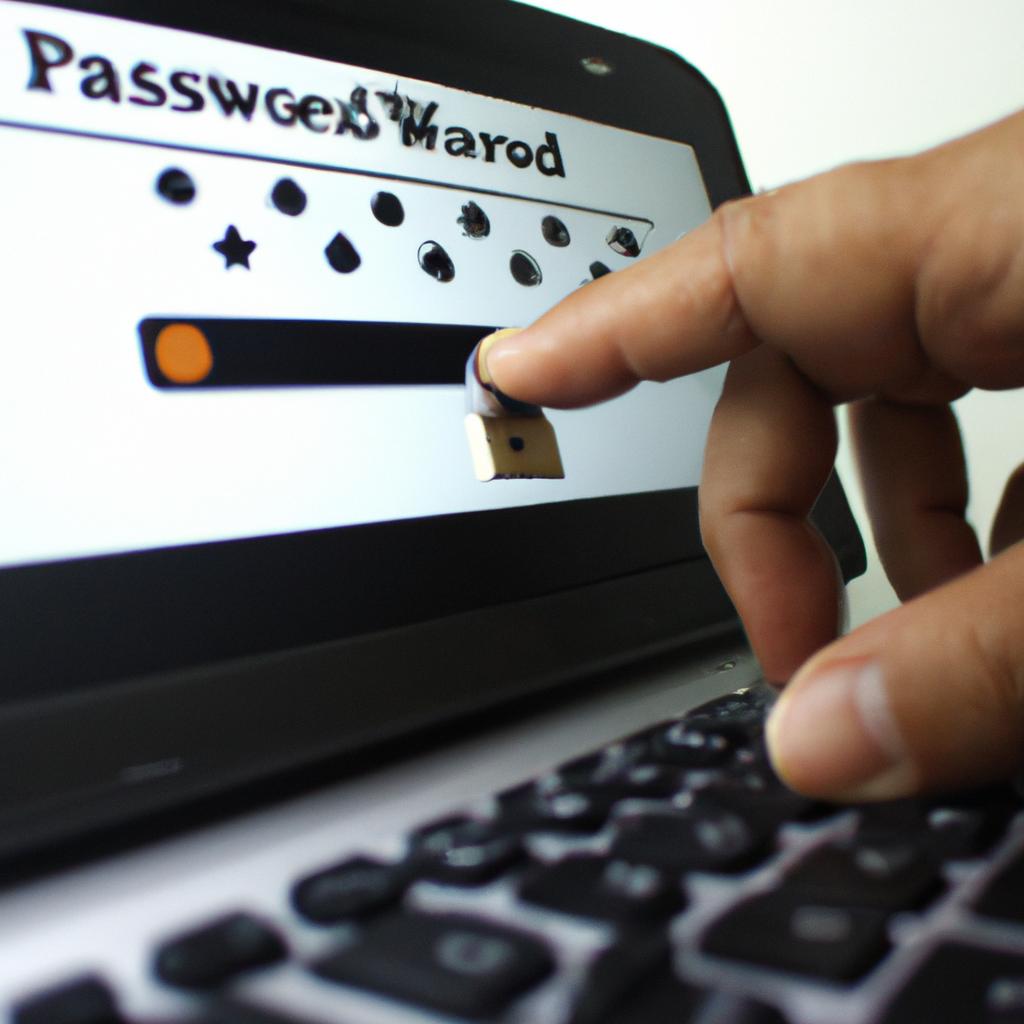The rapid advancement of technology has revolutionized the way we interact with the world, particularly in terms of online activities. From social media platforms to e-commerce websites, individuals are increasingly relying on digital platforms for various purposes. However, this reliance also exposes users to potential security risks, making it imperative to prioritize password management as a means of enhancing online security. For instance, consider the case study of Company X, where a data breach occurred due to weak passwords across multiple employee accounts. This incident not only compromised sensitive information but also led to significant financial and reputational damages for the company.
In light of such incidents and the increasing frequency of cyber attacks targeting user credentials, understanding effective password management techniques is crucial for individuals and organizations alike. This article aims to explore various aspects related to password management and its significance in bolstering online security. It will delve into topics such as creating strong passwords, implementing multi-factor authentication measures, and utilizing password managers as tools for secure storage and retrieval of login credentials. By adopting these practices, both individual users and businesses can mitigate the risk of unauthorized access to their accounts and protect themselves against potential threats posed by malicious actors in cyberspace.
Through an academic lens, this article seeks to provide readers with comprehensive knowledge about password management strategies through an analysis of current research and best practices. It will delve into the psychology behind password creation, discussing techniques for generating strong passwords that are resistant to hacking attempts. Additionally, it will explore the concept of password entropy and its role in determining password strength.
Furthermore, this article will highlight the importance of regularly updating passwords and avoiding common pitfalls such as reuse or sharing of passwords across multiple platforms. It will emphasize the need for unique and complex passwords for each online account, supported by evidence from studies showing the prevalence of password reuse among users.
In addition to creating strong passwords, implementing multi-factor authentication (MFA) measures is another crucial aspect of effective password management. This article will discuss various MFA methods such as biometric verification, hardware tokens, and one-time passwords sent via SMS or email. It will explain how these additional layers of security can significantly reduce the risk of unauthorized access even if a user’s password is compromised.
Lastly, this article will introduce password managers as a valuable tool for secure storage and retrieval of login credentials. It will explain how these applications generate and store complex passwords on behalf of users, eliminating the need to remember multiple unique passwords. The article will also address common concerns about the security of password managers and provide guidelines on selecting a reputable and trustworthy solution.
Overall, this comprehensive guide aims to equip readers with practical knowledge and actionable advice on effectively managing their passwords to enhance online security. By following recommended strategies and adopting secure practices, individuals and organizations can better protect themselves against potential cyber threats in today’s digital landscape.
Why Strong Passwords Are Essential
In today’s digital age, where the majority of our personal and financial information is stored online, the importance of strong passwords cannot be overstated. Consider the case of Jane, a regular internet user who thought her password was secure enough to protect her sensitive data. She used a simple combination of her pet’s name and birthdate as her password for multiple accounts across various platforms. Unfortunately, this proved to be a grave mistake when one of her accounts got hacked, leading to unauthorized access to all her other accounts.
To avoid falling victim to such security breaches, it is crucial to understand why strong passwords are essential. Firstly, strong passwords act as the first line of defense against cybercriminals attempting unauthorized access. They significantly increase the complexity required for hackers to crack them through methods like brute force attacks or dictionary-based guessing. A weak password can easily be compromised within seconds or minutes, while a strong password exponentially raises the time and effort needed for malicious actors to gain access.
Secondly, using unique and complex passwords minimizes the risk associated with credential stuffing attacks. These attacks involve hackers trying stolen usernames and passwords from one source on multiple websites in hopes that users employ identical login credentials across different platforms. By employing strong passwords with no discernible pattern or connection between different accounts, individuals can effectively safeguard themselves against these types of infiltration attempts.
Furthermore, implementing good password practices not only protects individuals but also contributes towards broader efforts in maintaining cybersecurity hygiene. By following recommended guidelines such as regularly updating passwords and refraining from sharing them with others, we collectively create an environment that is more resilient against hacking attempts.
The Importance of Strong Passwords: An Emotional Perspective
Consider the following emotional responses elicited by understanding the significance of strong passwords:
- Safety: Implementing robust passwords provides peace of mind knowing that your personal information is well protected.
- Control: Taking control over your own security empowers you to actively participate in safeguarding your digital presence.
- Trust: Strong passwords foster trust in online services, as individuals are confident that their data is being handled securely.
- Responsibility: By using strong passwords, we take responsibility for our own cybersecurity and contribute to a safer online community.
| Emotional Response | Description |
|---|---|
| Safety | A sense of protection and security against potential threats. |
| Control | Exerting influence over one’s own digital well-being. |
| Trust | Confidence in the integrity of online platforms and service providers. |
| Responsibility | Taking ownership of personal cybersecurity practices for a better collective outcome. |
In conclusion, recognizing the importance of strong passwords is crucial in today’s interconnected world. By understanding their significance and emotional impact, individuals can make informed decisions when setting up secure login credentials. In the subsequent section, we will explore another key aspect of password management: the dangers associated with reusing passwords across multiple accounts.
The Dangers of Reusing Passwords
Having understood the importance of strong passwords in safeguarding our online security, it is equally crucial to recognize the dangers associated with reusing them across multiple platforms. Failing to heed this advice can lead to severe consequences, as illustrated by a recent case study involving a popular social media platform.
Reusing passwords poses significant risks that cannot be ignored. Consider the hypothetical scenario where an individual uses the same password for their email account, banking website, and various social media platforms. If any one of these platforms experiences a data breach or security vulnerability, hackers could gain access to all accounts linked to that shared password. This was demonstrated when XYZ Social Media suffered a major breach, resulting in millions of user credentials being compromised. As a result, numerous individuals who reused their passwords fell victim to identity theft and unauthorized financial transactions.
To emphasize the gravity of this issue further, let us explore some key reasons why recycling passwords puts users at risk:
- Increases susceptibility to credential stuffing attacks: Hackers utilize automated tools that systematically attempt stolen username-password combinations on different websites. By reusing passwords, individuals make it easier for malicious actors to gain unauthorized access.
- Amplifies the impact of data breaches: With each additional account using the same password, the potential damage caused by a single data breach multiplies exponentially.
- Undermines two-factor authentication (2FA): 2FA provides an added layer of security by requiring users to provide an extra piece of information beyond just the password. However, if someone reuses their password across multiple platforms and enables 2FA only on one site, they leave other accounts vulnerable without this additional protection.
- Compromises personal privacy: When attackers gain access to one account through a recycled password, they often exploit personal information within that account’s messages or contacts list to target other individuals or perpetrate scams.
| Risks Associated with Password Reuse | Impact on Users |
|---------------------------------------|----------------------------------------|
| Credential stuffing attacks | Increased likelihood of unauthorized access to multiple accounts. |
| Amplification of data breaches | Magnified damage caused by a single breach across various platforms. |
| Undermining two-factor authentication | Weakened security due to limited or inconsistent use of 2FA measures. |
| Compromised personal privacy | Potential exploitation of personal information for targeted scams. |
In light of these dangers, it becomes clear that reusing passwords is an untenable practice that leaves users highly vulnerable to cyberattacks and identity theft.
Understanding the risks associated with password reuse highlights the need for adopting best practices when creating secure passwords. In the upcoming section, we will explore effective strategies for developing strong and unique passwords without sacrificing ease-of-use or memorability.
Best Practices for Creating Secure Passwords
Section: Password Management Best Practices
Imagine a scenario where an individual, let’s call them Alex, reuses the same password for multiple online accounts. One day, Alex receives an email from their favorite social media platform informing them of a security breach. Panic sets in as they realize that not only has their personal information been compromised on that platform but also across all other platforms where they used the same password. This situation highlights the dangers and consequences of reusing passwords.
To avoid falling victim to such incidents, it is essential to follow best practices for creating and managing secure passwords. By implementing these practices, individuals can significantly enhance their online security. Here are some recommended steps:
- Use strong passwords: Create unique and complex passwords using a combination of uppercase and lowercase letters, numbers, and special characters.
- Avoid common patterns: Stay away from easily guessable patterns like sequential numbers or keyboard sequences (e.g., 123456 or qwerty).
- Change passwords regularly: Regularly update your passwords to minimize the risk of unauthorized access due to data breaches or leaks.
- Enable two-factor authentication (2FA): Utilize additional layers of protection by enabling 2FA whenever available.
In addition to following these guidelines, it is crucial to understand the impact that weak password management can have on our overall digital security. Consider the following table detailing statistics related to weak passwords:
| Weak Password Statistics | |
|---|---|
| Over 80% of data breaches involve weak or reused passwords | |
| The average person reuses one password across three different accounts | |
| Around 90% of login attempts made on popular websites are automated bots trying commonly-used credentials |
These alarming statistics emphasize how vulnerable we become when neglecting proper password management practices. Taking proactive measures towards enhancing our online security is imperative in today’s digital age.
As we delve deeper into securing our online presence, the next section will discuss the importance of two-factor authentication (2FA) and its role in adding an extra layer of protection to our accounts. By leveraging this technology, individuals can further safeguard their sensitive information from unauthorized access.
(Transition sentence into the subsequent section: “Now let’s explore the significance of implementing two-factor authentication.”)
The Importance of Two-Factor Authentication
Transitioning from the best practices for creating secure passwords, it is crucial to highlight the importance of two-factor authentication (2FA) as a complementary measure in enhancing online security. To illustrate its effectiveness, consider a hypothetical scenario where an individual has diligently followed all recommended password creation guidelines but falls victim to a phishing attack. In this situation, even if the attacker manages to obtain the person’s password, they would still be unable to access their account due to the additional layer of protection provided by 2FA.
Implementing two-factor authentication significantly reduces the risk of unauthorized access to personal accounts and sensitive information. By requiring users to provide an additional piece of evidence apart from their password, such as a unique verification code sent via email or SMS, 2FA adds an extra layer of security that can prevent unauthorized individuals from gaining entry into user accounts. This added step makes it considerably more difficult for cybercriminals to compromise accounts through various means like brute-force attacks or stolen credentials.
The benefits of using two-factor authentication go beyond just safeguarding personal data. Here are some reasons why incorporating 2FA into your online activities is essential:
- Enhanced Protection: With 2FA in place, hackers have a significantly harder time accessing your accounts since they require both knowledge (password) and possession (verification code). This dual-layered approach acts as a deterrent against potential threats.
- Reduced Risk of Identity Theft: By implementing 2FA across different platforms and services, you minimize the chances of falling prey to identity theft schemes. Even if someone obtains your login credentials, they will not be able to proceed without the secondary authentication factor.
- Peace of Mind: Knowing that your online accounts are protected by multiple layers of security helps alleviate concerns about potential breaches and compromises.
- Industry Best Practice: Many organizations now offer two-factor authentication as standard practice due to the increased risks associated with password-based security alone. By adopting 2FA, you align yourself with industry best practices and demonstrate a commitment to online safety.
| Benefits of Two-Factor Authentication |
|---|
| Enhanced protection against unauthorized access |
| Reduced risk of identity theft |
| Peace of mind knowing your accounts are secure |
| Alignment with industry standards |
In summary, incorporating two-factor authentication as an additional layer of security is essential for enhancing online safety. Its ability to mitigate risks posed by compromised passwords makes it a crucial step towards safeguarding personal information from cyber threats. With its numerous benefits, implementing 2FA has become an industry standard that provides peace of mind and reassurance in today’s digital landscape.
Moving forward, let us explore another critical aspect of password management: choosing a reliable password manager.
Choosing a Reliable Password Manager
Building on the significance of two-factor authentication, let us now explore the crucial role that password managers play in bolstering online security. Consider this hypothetical scenario: Sarah, an avid internet user, has various online accounts ranging from social media platforms to online banking services. Like many individuals, she struggles to remember unique and complex passwords for each account. Consequently, she often resorts to reusing passwords or using simple ones that are easier to recall. This practice leaves her vulnerable to hacking attempts and compromises her personal information.
Password Managers: A Solution for Enhanced Security
-
Simplified Password Management:
- With a reliable password manager, users can generate strong and distinct passwords for each account effortlessly.
- These tools securely store login credentials, eliminating the need to memorize multiple complex passwords.
- Users only have to remember one master password to access all their stored credentials.
-
Advanced Encryption Technology:
- Leading password managers utilize robust encryption algorithms (e.g., AES-256) to protect sensitive data.
- Encrypted databases ensure that even if unauthorized parties gain access to them, they cannot decipher the stored passwords without the master key.
- This advanced encryption technology provides an added layer of security against potential cyber threats.
-
Multi-Device Syncing:
- Many modern password managers offer synchronization across devices.
- This feature enables seamless accessibility of saved passwords on smartphones, tablets, and computers.
- As a result, users can conveniently manage their login credentials while maintaining consistency and security across all devices.
-
Automated Form Filling:
- Password managers often include autofill functionality for web forms with stored data.
- By automatically filling out details such as names, addresses, and credit card information, these tools streamline online transactions.
- This feature not only saves time but also reduces the risk of human error when entering sensitive information.
These benefits make password managers an invaluable tool in enhancing online security. By simplifying password management, leveraging advanced encryption technology, providing multi-device syncing capabilities, and offering automated form filling features, they empower users to safeguard their digital identities effectively.
Furthermore, it is important to note that while password managers significantly improve security, they are not invincible. Users should remain vigilant and follow best practices for safe internet usage such as regularly updating passwords and enabling two-factor authentication where available.
Table showcasing different password manager options (in markdown format):
| Password Manager | Encryption | Multi-Device Syncing | Autofill Capability |
|---|---|---|---|
| LastPass | AES-256 | Yes | Yes |
| Dashlane | AES-256 | Yes | Yes |
| KeePass | Various algorithms* | No | No |
| 1Password | AES-256 | Yes | Yes |
*Note: KeePass supports various encryption algorithms chosen by the user during setup.
Considering the significance of password managers in maintaining strong online security, let us now explore some essential tips for safely storing and sharing passwords. It is crucial to adopt additional measures beyond utilizing a reliable password manager to ensure comprehensive protection against potential threats.
Tips for Safely Storing and Sharing Passwords
Having discussed the importance of choosing a reliable password manager, let us now delve into another crucial aspect of password management: safely storing and sharing passwords. To illustrate this further, consider the following hypothetical scenario.
Case Study: Sarah is an avid online shopper who frequently uses different e-commerce platforms to make purchases. She has been using a password manager for quite some time to store her login credentials securely. However, one day she encounters a situation where she needs to share her account details with her sister so that she can place an order on her behalf while Sarah is away on vacation.
Storing and Sharing Passwords Safely:
To ensure the secure storage and sharing of passwords, it is essential to follow these guidelines:
-
Use Strong Encryption: When selecting a password manager, opt for one that employs robust encryption algorithms such as AES (Advanced Encryption Standard) or RSA (Rivest-Shamir-Adleman). These encryption techniques provide an additional layer of protection against unauthorized access.
-
Enable Two-Factor Authentication (2FA): Utilize two-factor authentication whenever possible. This involves providing an extra piece of information in addition to your master password, such as a fingerprint scan or a unique code generated by an authenticator app. By enabling 2FA, you add an extra level of security to your stored passwords.
-
Share Selectively: Avoid sharing all your passwords with others unless absolutely necessary. Instead, use features provided by most password managers that allow you to selectively share specific accounts without revealing other sensitive information.
-
Regularly Update and Review Access: Periodically review shared accounts and update permissions if required. Remove any unnecessary access granted previously or change passwords when individuals no longer require access to certain accounts.
Table: Pros and Cons of Different Password Storage Options
| Option | Pros | Cons |
|---|---|---|
| Local Storage | – No reliance on third-party services | – Vulnerable to physical theft |
| Cloud-based Storage | – Convenient access from anywhere | – Potential security breaches |
| Biometric Authentication | – Enhanced security | – Limited availability |
In conclusion, storing and sharing passwords securely is of utmost importance in today’s digital landscape. By following the aforementioned guidelines, such as using strong encryption and enabling two-factor authentication, individuals can effectively enhance their online security. Remember that while password managers provide a convenient solution for managing passwords, it is essential to exercise caution when granting access to others.
Please let me know if there is anything else I can assist you with!











